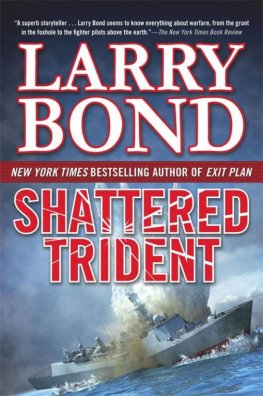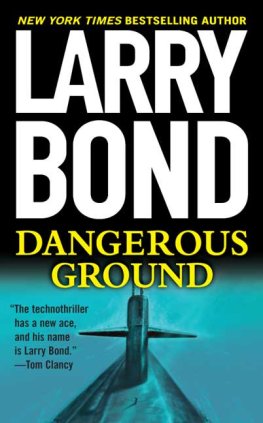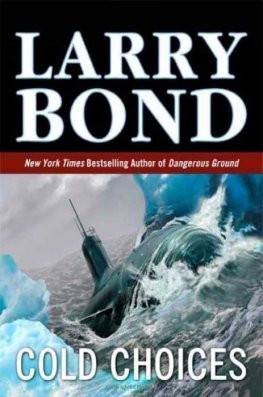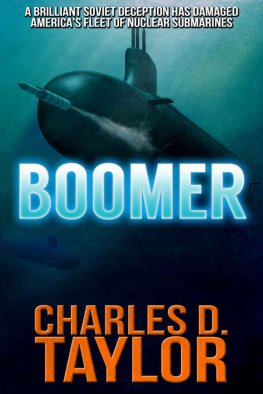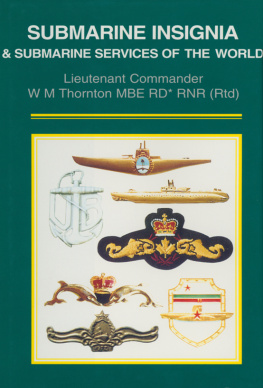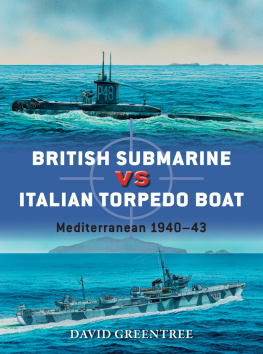Larry Bond
SHATTERED TRIDENT
This book is dedicated to our patient and understanding wives, Jeanne and Katy, who graciously put up with the numerous long conversations, as well as the many nights and weekends we left them abandoned while we typed like madmen. Without their faithful love and support, this book, indeed the entire Jerry Mitchell series, could not possibly have been written.

We are deeply grateful to William S. Murray, associate research professor at the Warfare Analysis and Research Division of the United States Naval War Colleges Center for Naval Warfare Studies, for his guidance and sage counsel. Professor Murrays insight into the Peoples Liberation Army Navy and undersea warfare made him an excellent sounding board for us to bounce our ideas against. He also patiently helped us as we wrapped our heads around that tumultuous body of water that is the South China Sea. The generous allocation of his time and expertise is greatly appreciated.

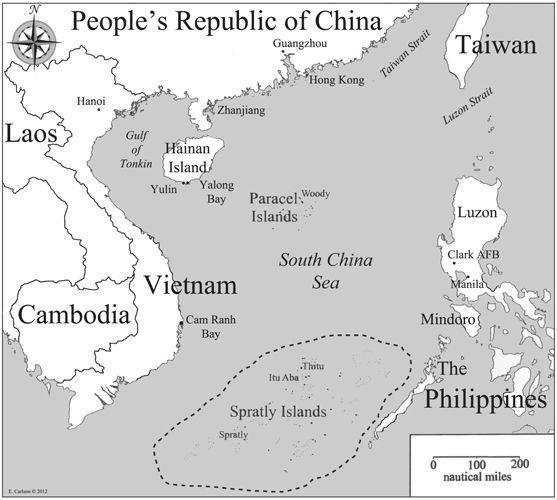
18 August 2016
South China Sea
Possible target zig by contact Sierra-three eight, based on frequency, sang out the sonar supervisor. Contact has either turned away or slowed down.
Commander Jerry Mitchell remained silent while the officer of the deck acknowledged the report. Glancing over his left shoulder, he could see the downward shift in the tonals on the sonar supervisors screen.
Confirm target zig by Sierra-three eight. Contact has come right, new course three five zero. No change in speed, announced the section tracking party coordinator.
Jerry shifted his attention to a large flat-screen display; the evolving tactical situation was constantly being updated by the subs fire control system. He shook his head slightly. It used to take several minutes and a couple of maneuvers by a trailing submarine to figure out a contacts new course after a zig. But now, they could recompute a targets course and speed in less than a minute. Somehow it didnt seem quite fair, but Jerry was fine with that.
Something wrong, Skipper? interrupted Lieutenant Iwahashi, the officer of the deck.
No, theres nothing wrong. Stay with her, Kiyoshi.
Aye, aye, sir. Pilot, right fifteen degrees rudder. Steady on course zero five zero.
Right fifteen degrees rudder, steady on course zero five zero, Pilot, aye. Officer of the deck, my rudder is right fifteen.
Very well, Pilot.
Pilot, Jerry thought ruefully. I still prefer helmsman. The change in some of the watch station nomenclature was but one of the many, many differences about this boat. His boat! Shivers still went up his spine every time the thought jumped into his mindhe was the captain.
USS North Dakota was brand-spanking-new, the first flight three Virginia-class nuclear-powered attack submarine in the fleet. As a class, the Virginias were revolutionary in many ways. One of the more obvious changes was in the control room. There werent any periscopes. None. No more dancing with the gray lady. An operator simply turned the mast-mounted video cameras with a joystick and watched the output on a flat-panel displayjust one among dozens that encircled the control room.
The flight three boats were the third and latest production group of the Virgina design, fitted with the next-generation sonar suite, built around entirely new hull and towed arrays. Without question, North Dakota had the best sonar suite in the world; built to find the quietest targets any potential adversary had at sea or on the drawing board. In the current situation, however, it was definitely overkill.
They had been trailing the Chinese Type 093 Shang-class nuclear-powered attack submarine for a day, hardly a challenge given how noisy these boats were. Jerrys sonar techs had first detected the Shang while she was tens of miles away, and with little effort Jerry had neatly maneuvered North Dakota into the Chinese boats baffles. Once settled in the sweet spot off the port quarter, North Dakota diligently shadowed her target; observing everything the Shang did, recording every squeak, thump, and whirl made by her propulsion plant. It all seemed too easy, and Jerry found himself repeatedly admonishing his crew to stay focused when they started getting a little too cocky.
Overconfidence will negate our technological advantage faster than anything the other guy could do. Stay sharp, hed warned them. The U.S. Navy knew little about blue-water Chinese submarine operations. Every hour he stayed in contact undetected meant more data, and a better understanding of the Peoples Liberation Army Navys submarine force.
Captain, that course change puts Sierra-three eight on an intercept track with Sierra-five two, reported Lieutenant David Covey, the tracking party coordinator.
Very well, Coordinator, Jerry responded. Then turning to Iwahashi, OOD, show me the two tracks.
Aye, sir. The junior officer pulled up a menu on the command workstation and zoomed out the tactical display.
Jerry studied the information on the port VLSD and did the math in his head as a quick check. The Shang was definitely closing in on the other contact, a merchant ship.
That cant be a coincidence, Skipper. Its a perfect intercept course, remarked Iwahashi. Maybe the Chinese captain is conducting an approach and attack drill?
Could be, Jerry speculated. They certainly should have picked up the merchant by now. A Shang may be hard of hearing, but they arent deaf. Sonar, what do you have on Sierra-five two?
Sir, Sierra-five twos signature matches the motor vessel Vinaship Sea in the database. She has a twelve-cylinder diesel with one four-bladed screw. Current shaft rate is 133 RPM, which correlates to twelve knots, the sonar supervisor answered smartly.
Very well, Sonar, Jerry replied. And before he could even ask, the OOD spoke up.
I have the Seawatch database entry here, sir. Putting it up on the starboard VLSD.
Excellent, Kiyoshi.
The picture of the Vinaship Sea flashed up onto the starboard large-screen display. The ship looked rather unremarkable. The superstructure and funnel were aft, with a raised island at the bow and four large deck cranes spaced evenly over the ships length.
Looks like a buckwheat bulk carrier to me, Jerry commented.
Yes, sir. Shes 169 meters long and displaces 18,108 gross tons. Built in 1998, she is currently owned by the Vinaship Jointstock Company and is registered in the Socialist Republic of Vietnam. According to ONI, she left the Tan Thuan Terminal at Ho Chi Minh port two days ago and is en route to Osaka, Japan. Cargo is listed as coal.
Jerry studied the merchants track. Again, his head shook slightly. The fire control system held her on course zero seven sixThat cant be right, he thought.
Coordinator, verify Sierra-five twos course, Jerry ordered.
Verify Sierra-five twos course, aye, sir. A few moments later Covey reported back. Confirm Sierra-five twos course is zero seven six, Captain.
Frowning, Jerry asked, Is it just me, or is that course too southerly for a Japanese destination? Quartermaster, what course would we steer if we were heading for Japan from Vietnam?
Working on it, Skipper, replied the quartermaster of the watch. He had just selected the appropriate digital chart from the library menu and was using the trackball to lay out a rough voyage-planning route. Sir, a better course from Ho Chi Minh would be about zero five zero, headed for the Hainan Strait. They are way too far south.

